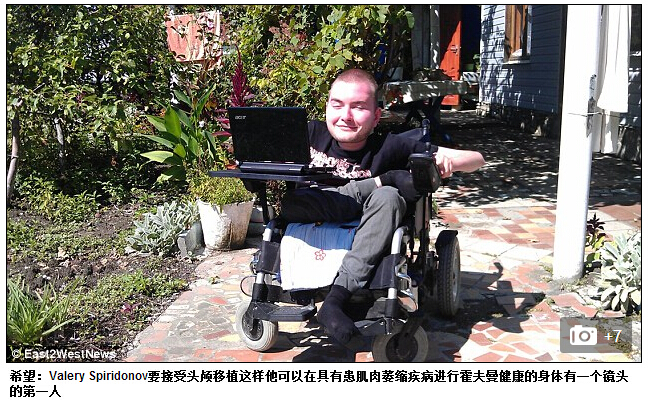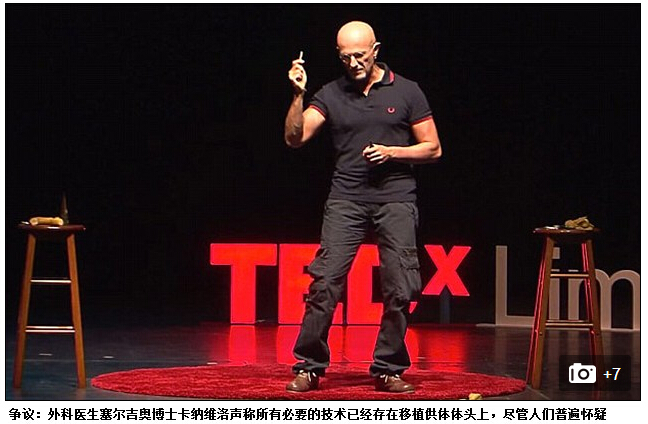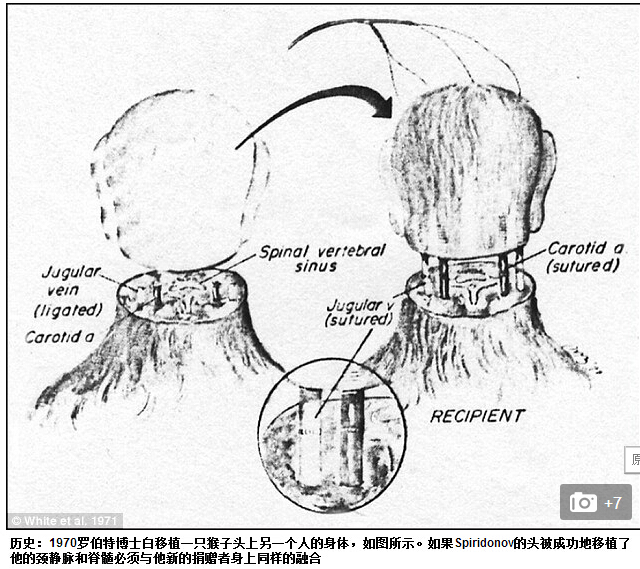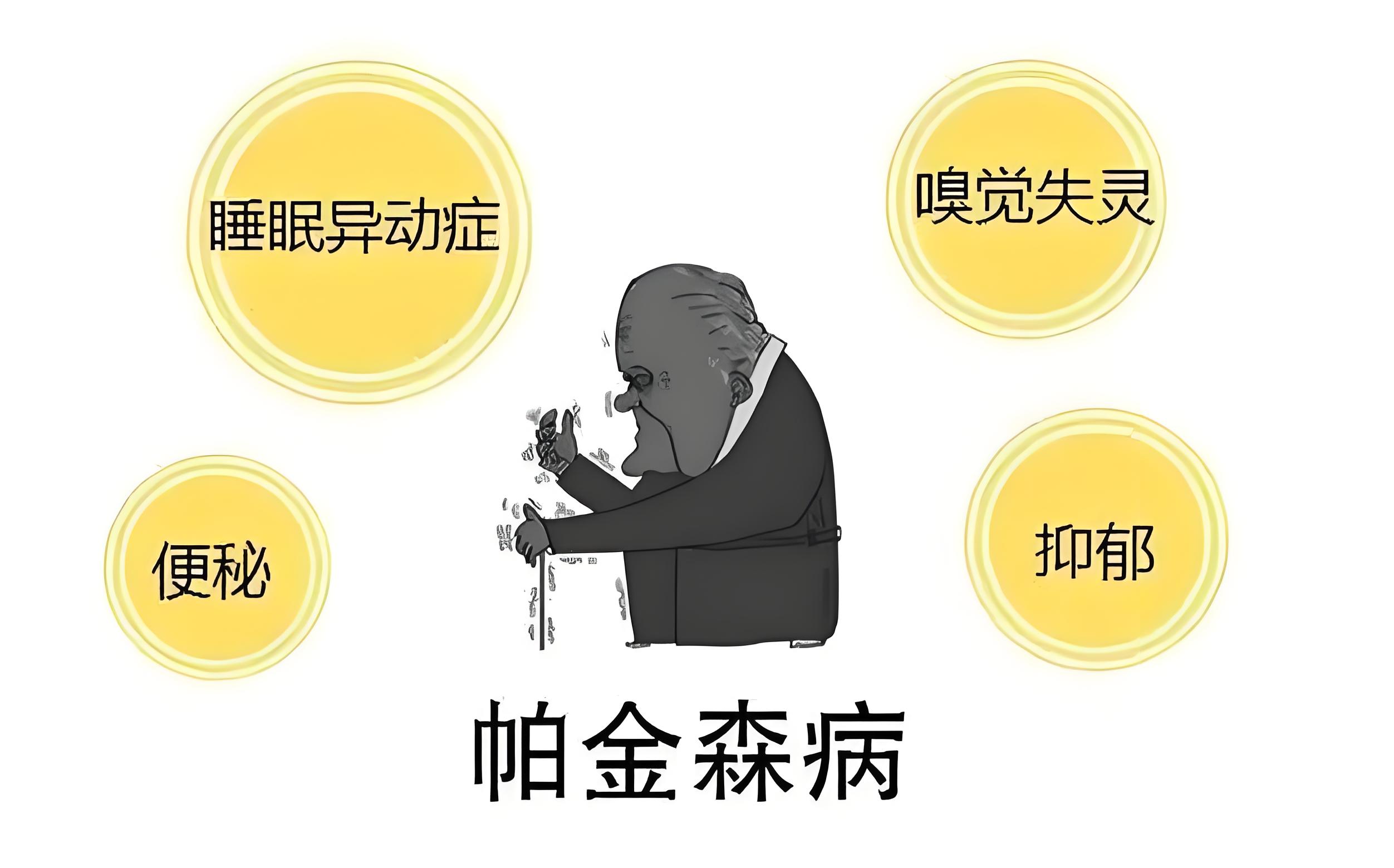一个男人他是如何成为进行头颅移植的第一人,希望可以尽快明年。瓦莱里Spiridonov说他准备把他的信任放在有争议的外科医生塞尔吉奥博士卡纳维洛声称他能砍下他的头并将它附加到一个健康的身体。
MR Spiridonov,30,一个来自俄罗斯,计算机科学家说:“我的决定是最终决定,我不打算改变我的想法。”作为一个终身的患者的罕见的遗传进行霍夫曼的肌肉萎缩性疾病,他说他想要一个新的身体的机会,在他死之前。“我害怕呢?是的,我当然。但这不仅仅是很可怕的,但也很有趣,说:”Spiridonov从他的家在弗拉迪米尔,莫斯科以东120英里的一个市。但你要明白,我没有很多的选择,”他说。如果我不尝试这个机会,我的命运会很伤心。每一年我状态越来越差。”

卡纳维洛博士和Spiridonov已经通过Skype尽管他们没有见过的医生没有了自己的医疗记录。意大利告诉美国有线电视新闻网他已经收到了很多电子邮件从人追求程序的信但他坚持认为,首先将患者患有肌肉萎缩病的人。DR卡纳维洛任命程序的天堂,这是头一个缩写吻合的风险。吻合手术连接包括两部分。他坚持所有必要的技术已经存在移植供体体头上。

第一只猴子头移植手术,45年前,在鼠标的基本操作进行了最近在中国。但批评者说,医生卡纳维洛的计划是纯粹的幻想”。意大利已比虚构的哥特式恐怖人物弗兰肯斯坦博士。亚瑟说,在纽约大学Langone医学中心医学伦理学主任,称为“坚果”卡纳维洛博士。亨特博士巴杰,当选美国神经外科医师协会,告诉美国有线电视新闻网:“我不希望这对任何人。我不会允许任何人这样做对我来说有很多事情比死亡更糟糕。”
36个小时的运行成本,它只能在一个世界上最先进的手术室进行,估计已经在?750万。新的身体就会从移植供者脑死亡但健康。捐献者和患者都会有自己的头脱离他们的脊髓的同时,采用超锋利的刀片提供一个整洁的。病人的头将被放置到捐赠者的身体,用什么卡纳维洛称他的“神奇成分的胶状物质称为聚乙二醇融合脊髓两端一起贴。肌肉和血液供应将被缝合,在病人进入昏迷四周停止他们移动,头部和身体愈合在一起。
当他们醒来的病人应该能够感受到他们的脸,甚至同一个声音说话。强大的免疫抑制药物应停止新的身体被拒绝。批评人士说,医生卡纳维洛简化参与附脊髓的困难。意大利医生也到目前为止未能获得资金150的医生和护士的工作人员认为需要完成的程序。然而,意大利自信他能成功地移植到另一个身体的头。
如果成功,他的创业过程可以成千上万瘫痪的残疾人提供新的希望。MR Spiridonov被诊断出患有罕见的肌肉萎缩的情况下,进行霍夫曼病,一岁。不幸的是疾病进展的每一天。他告诉每日邮报:“我几乎不能控制我的身体了。我需要帮助的每一天,每一分钟。我现在30岁了,虽然很少有人活到20以上患有这种疾病。”
他继续说:“我的肌肉停止儿童发展。正因为如此,他们没有成长和骨架发生变形。背部肌肉无法支撑骨架。”他的情况恶化的每一天,他渴望工作Spiridonov技术。他说道:“如果你想做,你需要参与。“我不明白这些手术的风险。他们是多。我们甚至不能想象什么可以去错了。恐怕我不会活着看到它发生在别人身上。”他说他的家人完全支持他的决定是第一个接受手术的人。
MR Spiridonov说:”更重要的是,已经有很多的精力投放在这个想法,这就是为什么回来得太晚。我想出了这个主意,前一段时间。我读了很多关于这一主题的科学论文。“不仅器官,但头部的研究已经有很长时间甚至由俄罗斯专家移植的想法。但人的头的一个实际的移植是没有进行。”MR Spiridonov联系有争议的医生,谁是总部在意大利的都灵大学,他的医疗索赔雄心勃勃的阅读后。他说:“我与教授卡纳维洛两年前对他的作品的阅读后。我给自己给他做这个手术可能。我们从来没有遇到过,我们只是通过电子邮件通信。
“在过去的两年里,我们一直在谈论这个想法和计划的运作。“他是一个非常有经验的神经外科医生和已经进行了许多严重的操作。当然,他从来没有做过这样的事情,我们必须仔细思考所有可能的风险。”俄罗斯比较了创业过程对战后的太空竞赛。他说:“它到底是像宇航员。在我们进入太空的第一人,300种不同的情况下出错的是想通过但当他真的做到了,这是怎么发生的第三百零一种情况。”
他说没有道德区别移植头上一个健康的身体,更换损坏的器官和一个健康的人,现在却被认为是常规。捐助者包括道路交通事故甚至被判处死刑的囚犯的受害者,他说。他说道:“我认为这是由于心脏或肾脏移植作为伦理。在一些时间点,这被认为是不道德的和。“有很多谈论人类的灵魂所在,如果做了心脏移植的伦理,但现在医生做,挽救人们的生命。

“我认为这是技术进化的正常方式。它将停止在这一点上的时候,是神经外科准备采取下一步行动奇怪。用于移植的尸体可能是那些人的大脑受损,比方说在汽车碰撞或摩托车事故,或谁被判处死刑。但是,当然,在未来的人类应该学会如何健康成长的身体的移植,所以不会有短缺的器官和遗体。”MR Spiridonov称他理解意大利外科医生只能前进时,他感到满意的是,医学是足够先进的。但俄罗斯他相信这一刻是非常密切的,可能明年,2016。他说道:“我们还没决定在特定的日期和卡纳维洛手术,“这是一个持续的过程,在很大程度上取决于正在进行的研究成功了。这将在我们这个夏天在安纳波利斯会议的神经外科。教授将在他的研究报告。他想让我在场。我想如果我能找到飞到那里参加的手段。我们将看到的下一步是什么之后。”
如果手术出错,可能会发生什么,俄罗斯甚至笑话。他告诉每日邮报:“也许我会尝试移动我的腿,而是我的身体会产生一公升的肾上腺素。但我愿意冒险和尝试。”1970罗伯特博士白移植一只猴子头上另一个人的身体在凯斯西储大学医学院。猴子死后八天因为身体拒绝头。猴子无法自己呼吸。动物不可能因为脊髓不连接的移动。巴杰博士说怀特的研究没有提供证据证明人类头颅移植工作。他告诉美国有线电视新闻网:这是在灵长类动物的一个45岁的参考,没有证据表明,脊髓功能的吻合。
原文
EXCLUSIVE: Revealed, the terminally ill man set to be first to undergo the world's first full HEAD transplant pioneered by doctor branded 'nuts'
A man with a fatal medical condition has spoken exclusively to MailOnline about how he is set to become the first person to undergo a head transplant and hopes it could be as soon as next year.Valery Spiridonov says he is ready to put his trust in controversial surgeon Dr Sergio Canavero who claims he can cut off his head and attach it to a healthy body.
Mr Spiridonov, 30, a computer scientist from Russia, said: 'My decision is final and I do not plan to change my mind.'
As a lifelong sufferer of the rare genetic Werdnig-Hoffman muscle wasting disease, he says he wants the chance of a new body before he dies.'Am I afraid? Yes, of course I am. But it is not just very scary, but also very interesting,' said Mr Spiridonov from his home in Vladimir, a city 120 miles east of Moscow.
'But you have to understand that I don't really have many choices', he said. 'If I don't try this chance my fate will be very sad. With every year my state is getting worse.'
Dr Canavero and Mr Spiridonov have talked via Skype though they have not met yet and the doctor has not reviewed his medical records.
The Italian told CNN he has received many email and letters from people seeking the procedure but he insists the first patients will be people suffering from a muscle wasting disease.
Dr Canavero has named the procedure HEAVEN, which is an acronym for head anastomosis venture. Anastomosis involves the surgical connecting of two parts.
He insists all the necessary techniques already exist to transplant a head onto a donor body.
The first monkey head transplant was performed 45 years ago and a basic operation on a mouse was carried out in China recently.But critics say Dr Canavero's plans are 'pure fantasy'. The Italian has been compared to the fictional gothic-horror character Dr Frankenstein.And Arthur Caplan, the director of medical ethics at New York University's Langone Medical Centre, has described Dr Canavero as 'nuts'.
Dr Hunt Batjer, president elect of the American Association for Neurological Surgeons, told CNN: 'I would not wish this on anyone. I would not allow anyone to do it to me as there are a lot of things worse than death.'
The cost of the 36-hour operation, which could only be performed in the one of the world's most advanced operating theatres, has been estimated at ?7.5million.
The new body would come from a transplant donor who is brain dead but otherwise healthy.Both donor and patient would have their head severed from their spinal cord at the same time, using an ultra-sharp blade to give a clean cut.
The patient's head would then be placed onto the donor's body and attached using what Canavero calls his 'magic ingredient' - a glue-like substance called polyethylene glycol - to fuse the two ends of the spinal cord together.The muscles and blood supply would be stitched up, before the patient is put into a coma for four weeks to stop them from moving while the head and body heal together.When they wake the patient should be able to move, feel their face and even speak with the same voice. Powerful immunosuppressant drugs should stop the new body from being rejected.
Critics say Dr Canavero has simplified the difficulties involved in reattaching a spinal cord.The Italian doctor has also so far failed to secure funding for the staff of 150 doctors and nurses he believes are required to complete the procedure.
However, the Italian is confident he can successfully transplant a head on to another body.And if successful, his pioneering procedure could give new hope to thousands of paralysed and disabled people.Mr Spiridonov was diagnosed with the rare muscle-wasting condition, Werdnig-Hoffman disease, at the age of one. Tragically the disease progresses every day.He told MailOnline: 'I can hardly control my body now. I need help every day, every minute. I am now 30 years old, although people rarely live to more than 20 with this disease.'He continued: 'My muscles stopped any development in childhood. Because of this, they do not grow and the skeleton gets deformed. The back muscles cannot support the skeleton.'
With his condition worsening each day, Mr Spiridonov is desperate for the technique to work. He told MailOnline: 'If you want something to be done, you need to participate in it.'I do understand the risks of such surgery. They are multiple. We can't even imagine what exactly can go wrong. I'm afraid that I wouldn't live long enough to see it happen to someone else.'He said his family fully support his decision to be the first human to undergo such surgery.Mr Spiridonov added: 'What's more, there's already a lot of effort invested in this idea and that's why it's too late to back out.
'I came up with this idea quite some time ago. I read many scientific articles on this topic.'The idea to transplant not only organs but the head has been studied for a long time even by Russian specialists. But an actual transplantation of the human head was never conducted.'Mr Spiridonov contacted the controversial doctor, who is based at the University of Turin in Italy, after reading about his ambitious medical claims.
He said: 'I contacted Professor Canavero two years ago after reading about his works. I offered myself to him to make this operation possible. We have never met and we just communicate via emails.
'For the last two years we've been talking this idea through and planning the operation.
'He's a very experienced neurosurgeon and has conducted many serious operations. Of course he has never done anything like this and we have to think carefully through all the possible risks.'
The Russian has compared the pioneering procedure to the space race of the post-war years.
He said: 'In the end it is like with astronauts. Before the first man we sent into space, 300 different scenarios of something going wrong were thought through but when he actually did it, it was the 301st scenario that happened.'
Mr Spiridonov denies his pledge to be a guinea pig is a stunt, and insists he goes into it with his eyes open.'If I want this kind of surgery to happen, I shouldn't put the responsibility onto someone else but should try it on myself.
'My family fully supports me. They also understand all the risks and even if they think that it's too dangerous, they still support me in my decision.'
Despite his severe disabilities Mr Spiridonov has lead a full life, graduating from university with a degree in computer science.'I lost my father in a car crash 16 years ago,' he told MailOnline. 'He was a military man, a lieutenant colonel. So I had to start supporting the family at an early age.'My mother is a child psychologist in a rehabilitation centre for children who got into difficult situations.
'I graduated from the Faculty of Information Technologies of Vladimir State University. I have a very active social life and I'm the head of a committee that deals with social policies for families and youth.'
He added: 'I don't do this because I don't have a life but I think that science is developed by those who are ready to take risks and devote themselves to it.'
Mr Spiridonov has never discussed the possibility of failure with Dr Canavero.
He told MailOnline: 'It was about me just offering myself as ready to undergo it. Of course, the professor considers the chances to succeed are quite high otherwise he wouldn't try it.'He says there is no ethical difference between transplanting a head on to a healthy body and replacing a damaged organ with a healthy one, which is now considered routine.Donors could include victims of road traffic accidents or even prisoners sentenced to death, he says.
He told MailOnline: 'I consider it to be as ethical as the transplant of the heart or kidneys. At some point of time this was considered to be unethical as well.
'There was much talk about where the human soul is located, and if it's ethical to do the heart transplants, but now doctors do it and save people's lives.
'I think it's the normal way of technology to evolve. It would be strange to stop at this point when the neurosurgery is ready to take the next step.'The bodies used for transplant could be those of people whose brain was damaged, let's say in a car crash or motorbike accident, or who are sentenced to capital punishment.'But, of course, in future humanity should learn how to grow healthy bodies for the transplants so there will be no shortage of organs and bodies.'Mr Spiridonov says he understands that the Italian surgeon can only go ahead when he is satisfied that medical science is sufficiently advanced.
But the Russian he believes this moment is very close, possibly next year, 2016.
He told MailOnline: 'We haven't agreed on a particular date of the surgery with Dr Canavero,'It's an ongoing process and a lot depends on the success of the studies that are underway now.'There will be a conference of neurosurgery in Annapolis in the US this summer. The professor will be reporting on his studies there.
'He would like me to be present. I would like to attend if I can find the means to fly there. We will see what the next step is after that.'
Matter-of-factly, he adds: 'For now we are thinking about transplanting my head in 2016.'The Russian even jokes about what might happen if the surgery goes wrong.
He told MailOnline: 'Maybe I would try to move my leg but instead my body will produce a litre of adrenaline. But I am willing to take the risks and try.'
In 1970 Dr Robert White transplanted the head of one monkey onto the body of another at the Case Western Reserve University School of Medicine.
The monkey died after eight days because the body rejected the head. The monkey was unable to breathe on its own. The animal could not move because the spinal cord were not connected.Dr Batjer says White's research does not provide evidence that a human head transplant can work.He told CNN: 'It's a 45-year-old reference in a primate and there is no evidence that the spinal cord was anastomosed functionally.'
Dr Sergio Canavero could not be reached for comment.



